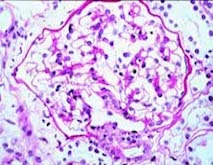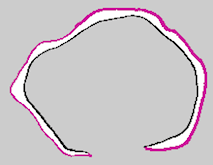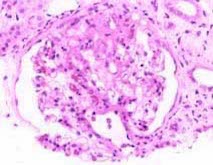- What is FSGS?
- What causes scars in the glomerulus?
- Primary FSGS with nephrotic syndrome
- Treatment of primary nephrotic syndrome
- Other causes of FSGS (secondary FSGS)
- Treatment of secondary FSGS
- Summary
- Where can I get further information?
Any condition that damages the glomeruli (filtering units of the kidney) in small areas may leave scars, and the kidney biopsy will then show FSGS – focal segmental glomerulosclerosis. However these scars are also sometimes seen in patients with nephrotic syndrome (a heavy protein leak into the urine) but without any other reason to have scars. It is this type of FSGS, known as Primary FSGS, that people usually mean when they talk about FSGS.
What is FSGS?
Glomeruli are the filtering units of the kidney. There are about one million glomeruli in each kidney. The name FSGS comes about in this way:
Focal means that some glomeruli are affected but not others
Segmental affecting only a segment of each glomerulus that is involved
-sclerosis scarring …
Glomerulo- of the glomeruli …
The diagnosis of FSGS can only be made after these scars have been seen on a kidney biopsy.
What FSGS looks like on a kidney biopsy. A normal glomerulus (left), and one with a scar affecting one segment (right – the scar is shown in pink in the diagram below). The top two pictures are from kidney biopsies. The ‘holes’ in the middle of the glomerulus are filled with flowing blood in life. The two below are diagrams showing the space into which urine is filtered (white), and a scar (pink). Each glomerulus is tiny – you could fit 10 side by side on the head of a pin. See where they are in normal function of the kidney.
What causes scars in the glomerulus?
There are many possible causes – other information besides the kidney biopsy is needed to decide between them. This table shows more causes than most doctors will remember.
Primary FSGS with nephrotic syndrome
This disease usually comes to attention by causing nephrotic syndrome, and sometimes by causing kidney failure and high blood pressure. Although it has some things in common with another common cause of nephrotic syndrome, minimal change disease, it also has some important differences:
- Occurs at all ages – not common in children
- Sometimes responds to steroid treatment (instead of almost always)
- Kidney function may be abnormal, and may get worse
- Can cause complete kidney destruction requiring dialysis and transplantation
- The disease may come back after a kidney transplant to affect the transplanted kidney
Minimal change disease is a common cause of nephrotic syndrome in which the glomeruli look completely normal on kidney biopsy. Occasionally FSGS may be mistaken for minimal change disease on the kidney biopsy, simply because the biopsy missed any of the glomeruli with scars in them.
Treatment of primary FSGS
Primary FSGS may be treated with high doses of steroids, as is given to patients with nephrotic syndrome caused by Minimal Change Disease. If the dose is high enough and continued for long enough, the nephrotic syndrome may improve in many patients. However some will not respond, and in others, the side effects may be very troublesome. Other treatments may help in some people mostly these are drugs that affect the immune system. Some further details of steroid and other treatments is available from our information on Immunosuppressive Drugs for Renal Diseases. If kidney function is reduced, treatments to prevent further deterioration are very important. See our information on chronic renal failure and its progression for further information. Treatment is likely to include strict blood pressure control, and may include dietary and other recommendations.
Other causes of FSGS (secondary FSGS)
FSGS with other causes may come to light because of proteinuria, raised blood pressure, or because of signs from blood tests that the kidneys are not working properly (renal failure).
Treatment of secondary FSGS
The treatments for these types of FSGS will differ according to the probable cause. In fact many of them do not require any special treatment often the scars are from a disease that has occurred in the past. However if there is enough damage to reduce kidney function, treatments to prevent further deterioration are very important. See our information on chronic renal failure and its progression for further information. Treatment is likely to include strict blood pressure control, and may include dietary and other recommendations.
![Summary]() Summary
Summary
| FSGS causes proteinuria and kidney damage, often with nephrotic syndrome. It can only be diagnosed after a kidney biopsy |
| In some patients it responds to treatment with steroids |
| In some it may cause progressive renal failure |
| FSGS can also be sometimes just a sign of previous kidney disease |
Other information
Our own literature and website, EdRenINFO, has further information on nephrotic syndrome (very relevant), chronic renal failure and its progression, minimal change disease, and proteinuria.
There is a good, short article on FSGS on the NKF-UK website.
Some very helpful patient’s stories can be found on the Nephcure site. Nephcure is a US support organisation that raises funds for research. In the UK, the NKRF is the major charity supporting renal research.
Acknowledgements: The author of this page was Neil Turner. It was first published in September 2000 and reviewed by Ben Reynolds in May 2010. The date is was last modified is shown in the footer.




